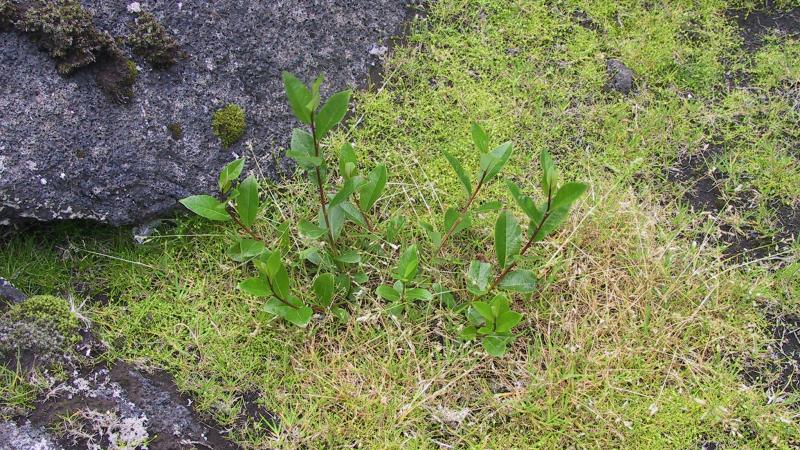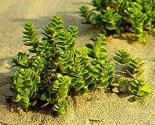The Volcano Island, Iceland. Plants. (original) (raw)
Colonization of life on Surtsey has been studied since the formation of the island.
Investigation carried out in the early days revealed that bacteria and fungi soon became
established in the fresh volcanic substrate.
In the summer of 1965 the first vascular plant was found growing on Surtsey, mosses became visible in 1968 and lichens were first found on the Surtsey lava in 1970. Plant colonization
on Surtsey has been closely studied, the vascular plants in particular as they have been of
far greater significance than mosses and lichens in the vegetation development.

Plot 14 in 1998 on sand-filled lava outside gull-colony.
Honkenya peploides had 2% cover, and was the only species in the plot.
Photo by © Borgthor Magnusson (taken from Magnusson & Magnusson 2000)
The island has been visited every summer and a record kept of colonizing species and
their fate. Initially, each individual plant that was found on Surtsey was marked on a map
and given a label. Measurements were made of its growth and development, through the
summer and from year to year.
Such detailed observations were possible while the number of plants on the island was
relatively small and it was continued untill 1978. After that time the focus has been more
on particular sites on the island where the general development has been followed

Leymus arenarius doesn't seem to have any problems on Surtsey now.
Part of photo by © Sigmar Metusalemsson
The first twenty years of vegetation colonization and succession on Surtsey were
characterized by invasion and spread of the coastal species Honkenya peploides,
Leymus arenarius and Mertensia maritima which formed a simple community on
the unfertile, sandy substrate on the island. Of the other seventeen species discovered on
the island during that period only seven managed to become established and spread
slightly but they were all insignificant in the vegetation.


 |
green: mosses red: honckenya blue: elymus arenarius yellow: other plants as cochlearia officinalis and carex maritima |
|---|
Map showing vegetation 1969, 1970 and 1976, while they yet counted
every single plant on the island. Red and blue have been enlargened to
show where the plants are growing. Notice the change in the formation if the island.
© Map from Surtsey Research Progress Report IX
' Vascular plants on Surtsey 1977-1980 ' by Sturla Fridriksson
At the end of the eruption in June 1967, the island had reached 2,7 km² in total area.
The highest point on Surtsey, 154 m asl, is on the eastern hill. The southern part of the
island is formed by lavaflows descending from the craters. The lava flows have to a large
extent been filled in by drifting tephra sand from the hills above them. The lava in the southeasternmost part of Surtsey is though still mostly free of sand, but airborne dust
has settled in hollows and fissures.
The northernmost part of Surtsey is a low ness, formed by eroded material carried by
the surf to the leeward side of the island. During winter sea water may wash over the
ness area in extreme storms. The coastal erosion has taken its toll of Surtsey and in
1998 the island had been reduced to 1,5 km².
The formation of the gull colony marked a new era in plant colonization and succession
on Surtsey as these gulls had considerably stronger impact than other breeding birds earlier established on the island.

Number of vascular plant species found on Surtsey during 1965-1999
© Taken from: Magnusson & Magnusson 2000.
The vegetation succession on Surtsey has changed considerably after the formation of the
gull colony. A number of new plant species have colonized the island, the nutrient status of
the soil has improved which has enabled nutrient demanding plants to become established
and also improved the condition of older species on the island.
The main species that have taken advantage of the improved conditons within the colony
area are Sagina procumbens, Poa annua, P.pratensis, Puccinellia distans, Cerastium fontanum, Cochlearia officinalis and Stellaria media. Most of these species prefer
disturbed and/or nutrient-rich habitats and have a high seed production. Poa annua and
stallaria media are annuals, but annual species had not been able to become firmly
established on Surtsey before the formation of the gull colony.

Plot 1 in 1998, on sanmd-filled lava inside gull colony. The plot had 9 plant species in 1998
and extent of bare ground was only 8%.

Honkenia peploides was the dominant species with 46% cover, while poa annua,
poa pratensis, stellaria media, cerastium fontanum and leymus arenarius also had a
relatively high cover in the plot.
Photo by © Borgthor Magnusson (taken from Magnusson & Magnusson 2000)
In the center of the gull colony, changes in vegetation composition and cover between years appear to have slowed down in the last few years. In some of the lava plots the cover of
sagina procumbens has started to decrease but the species has not disappeared in any
of the plots yet.
I have been wondering how long it would last till the first bush or tree showed up on Surtsey.
Now I don't have wo wonder any longer. They have arrived the island already:

this salix (which can reach a height of 4 meters, Salix phylicifolia, arrived in 1998.
Photo by © Borgthor Magnusson
According to my present very limited knowledge to latin names, the above bush can be up
to 4 meters high, but I presume that there will be no larger forest on the island for at least
a couple of years yet???
Main references of this section on plants of Surtsey:
Magnusson, B. and S. H. Magnusson, 2000. Vegetation on Surtsey, Iceland,
during 1990-1998 under the influence of breeding gulls. Surtsey Research 11: 9 - 20.
Table showing the 57 species found so far, and the year first observed:
More text if you click on the latin name; Original picture: click on the picture
| 1965 | Cakile arctica Away between 1981-86 and 88-94 |  |
|---|---|---|
| 1966 | Elymus arenarius |  |
| 1967 | Honkenya peploides |  |
| Mertensia maritima |  |
|
| 1969 | Cochlearia officinalis |  |
| 1970 | Stellaria media Away from 1974-1988 |  |
| 1971 | Cystopteris fragilis |  |
| 1972 | Angelica archangelica Away between 1974-1997 |  |
| Carex maritima | ||
| Puccinellia distans | ||
| Matricaria maritima |  |
|
| 1973 | Festuca rubra | |
| 1975 | Cerastium fontanum | |
| Equisetum arvense |  |
|
| Silena acaulis |  |
|
| Juncus arcticus | ||
| Poa pratensis | ||
| Sagina procumbens | ||
| 1977 | Atriplex patula | |
| 1978 | Rumex acetosella |  |
| Cardaminopsis petraea |  |
|
| Capsella bursa-pastoris |  |
|
| 1986 | Armeria maritima |  |
| 1987 | Poa annua | |
| Agrosis stolonifera | ||
| 1990 | Alchemilla vulgaris |  |
| Epilobium palustre |  |
|
| Luzula multiflora | ||
| 1991 | Taraxacum spp. | |
| Rumex acetosa | ||
| Polygonum aviculare | ||
| 1992 | Agrostis capillaris | |
| Alopecurus geniculatus | ||
| Ranunculus acris | ||
| 1993 | Deschampsia beringensis | |
| Empetrum nigrum | ||
| Agrostis vinealis | ||
| Eleocharis quinqueflora | ||
| 1994 | Phleum pratense | |
| Montia fontana | ||
| Poa glauca | ||
| 1995 | Juncus alpinus | |
| Salix herbaceae | ||
| Galium normanii | ||
| 1996 | Potentilla anserina | |
| Anthoxanthum odoratum | ||
| Leontodon autumnalis | ||
| Rumex longifolius | ||
| Polypodium vulgare | ||
| Puccinellia maritima | ||
| 1997 | Luzula spicata | |
| Myosotis arvensis | ||
| 1998 | Salix phylicifolia | |
| Oxyria digyna | ||
| 2002 | Ceutorhynchus insularis | |
| Plantago maritima |  |
Bildene og linkene er i hovedsak hentet fra - og peker til
'Den virtuella floran'
fra Naturhistoriska riksmuseet i Stockholm,
hvor man finner ytterligere omtale, samt navn på andre språk, bl.a. norsk.
Here you will find more about:
 |
Birds |
|---|---|
 |
Bird migration |
 |
Insects |
 |
Sealife |
 |
Fossils on Surtsey |
 |
How life developed |
 |
The eruption |
 |
Picture-review |
See the last report from Surtsey Research - 2009. Click here
Any questions, or a feeling of knowing more, just get in touch!